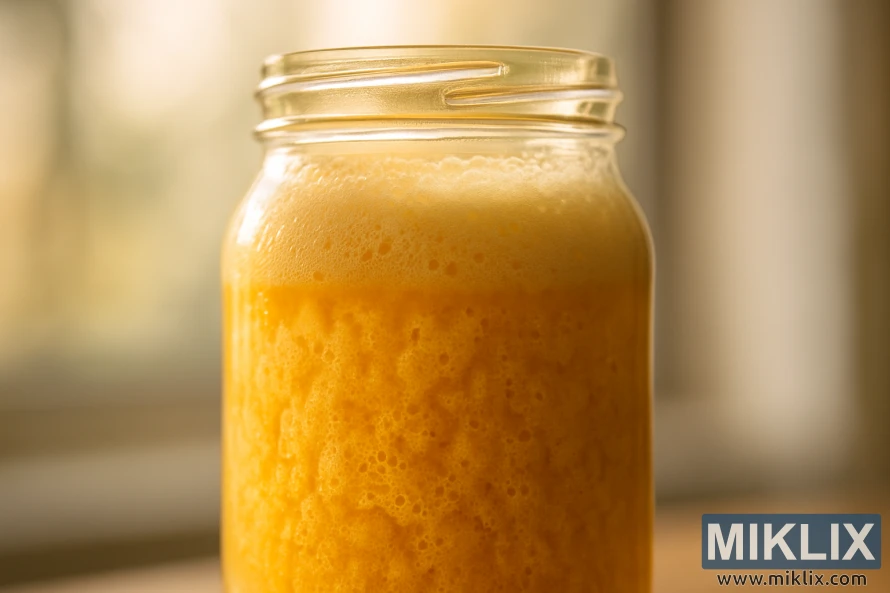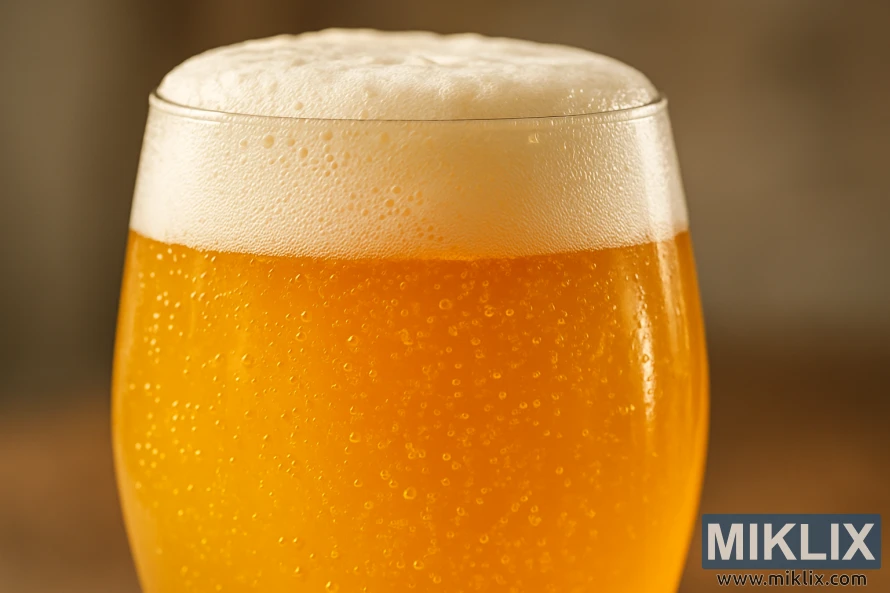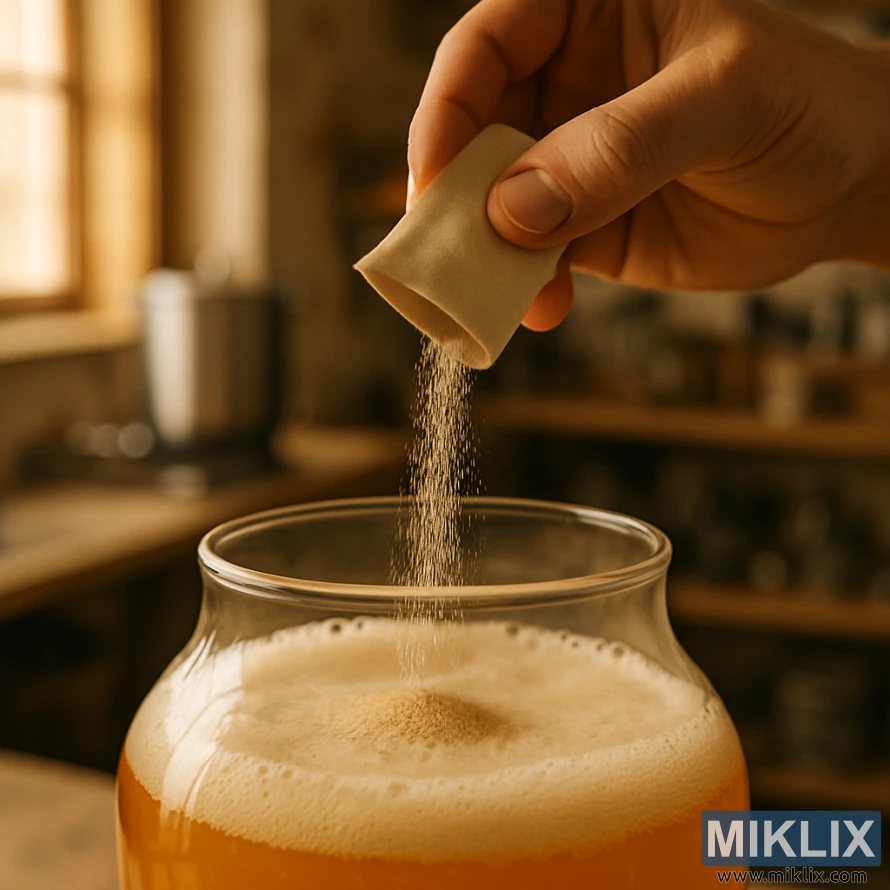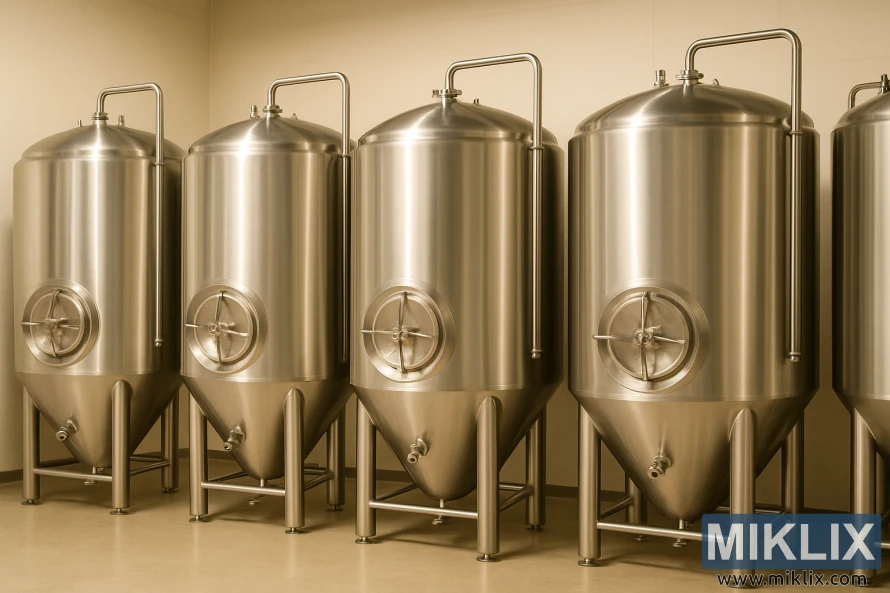Fermenting Beer with Mangrove Jack's M20 Bavarian Wheat Yeast
Published: September 22, 2025 at 9:06:28 PM UTC
Last updated: September 25, 2025 at 6:04:48 PM UTC
Mangrove Jack's M20 Bavarian Wheat Yeast is a dry, top-fermenting strain designed for authentic Hefeweizen character. It's favored by both homebrewers and professional brewers for its banana and clove aromas. These aromas are complemented by a silky mouthfeel and a full body. The strain's low flocculation ensures yeast and wheat proteins remain suspended. This results in the classic hazy appearance expected from Bavarian wheat beer.

This M20 review is based on practical data and user feedback. At a consistent 19°C, fermentations have reached a final gravity near 1.013 in about four days. This shows reliable attenuation and moderate alcohol tolerance. Guidance on fermentation temperature, pitching, and storage will help you achieve consistent results when fermenting with this Bavarian wheat yeast.
Key Takeaways
- M20 delivers classic banana and clove esters ideal for Hefeweizen yeast profiles.
- Low flocculation supports a hazy, full-bodied appearance and smooth mouthfeel.
- Typical fermentation at ~19°C can reach FG ~1.013 within days.
- Suitable for both homebrewers and commercial batches aiming for authentic Bavarian wheat beer.
- Pay attention to pitching rate, temperature control, and storage for best results.
Why Choose a Bavarian Wheat Yeast for Authentic Hefeweizen
Brewers opt for a dedicated Bavarian wheat strain for genuine Hefeweizen authenticity. These yeasts are engineered to produce significant amounts of esters and phenolics. This results in the distinctive banana flavor from isoamyl acetate and the clove spice from 4-vinyl guaiacol.
The characteristics of wheat beer yeast significantly influence both aroma and taste. Their low flocculation ensures yeast remains suspended, creating a hazy appearance and a smooth mouthfeel when combined with wheat malts. This texture is as critical to the style as the fruity and spicy flavors.
Temperature responsiveness allows brewers to fine-tune flavor balance. A strain with a well-defined fermentation range enables adjusting ester or phenol prominence by altering fermentation temperature. This makes achieving the precise Hefeweizen authenticity desired much easier.
M20 and similar Bavarian dry yeasts offer practical benefits for homebrewers. They are easy to store, simple to rehydrate or pitch, and eliminate the need for maintaining liquid cultures. For those inquiring about Bavarian wheat yeast, the combination of predictable wheat beer yeast characteristics and ease of use stands out as a significant advantage.
Overview of Mangrove Jack's M20 Bavarian Wheat Yeast
Mangrove Jack's M20 is a top-fermenting dry strain, renowned for its authentic German wheat beer taste. This yeast is a favorite among homebrewers for crafting Hefeweizen, Dunkelweizen, Weizenbock, and Kristallweizen. Its popularity stems from its ability to deliver a true-to-style flavor.
The yeast profile is characterized by strong banana esters and clove-like phenolics. Homebrewers often describe the mouthfeel as creamy and silky. They also note occasional vanilla-like aromatics that enhance the wheat malt's flavor.
Mangrove Jack's M20 specs indicate a fermentation range of 64–73°F (18–23°C). While some guidance suggests a broader tolerance of 59–86°F (15–30°C), it's important to note that flavor profiles can vary outside the core range.
- Attenuation: medium, roughly 70–75% for balanced body.
- Flocculation: low to preserve haze and traditional appearance.
- Alcohol tolerance: up to about 7% ABV for stronger styles.
- Pack size: single sachet pitched for 5–6 gallon (20–23 L) batches.
Retail pricing for a single sachet is commonly around $4.99. This information is useful for brewers to estimate costs per batch when comparing different yeast options.
By understanding the M20 overview and Mangrove Jack's M20 specs, brewers can align yeast choice with their recipe goals. The yeast's profile ensures a reliable Bavarian character and traditional haze retention, making it a go-to choice for many.
Mouthfeel and Appearance Contributions of M20
Mangrove Jack's M20 offers a silky-smooth, creamy mouthfeel that matches the wheat beer body brewers often seek. Its low flocculation ensures yeast and wheat proteins remain suspended. This creates a rich, creamy texture on the palate.
The presence of suspended yeast and proteins also contributes to the beer's hazy Hefeweizen appearance. You can expect a light golden haze that reflects the traditional style. Brewers aiming for a clear Kristallweizen will need to employ additional fining or filtration.
Commercial and homebrewers frequently note banana and vanilla aromas alongside full-bodied flavors. These scents, combined with the mouthfeel, enhance the beer's perceived fullness. They also leave a lasting aftertaste that reinforces the authenticity of wheat beers.
When brewing with M20, anticipate a prolonged haze retention and a rounded mouthfeel. If you prefer a drier, lighter finish, adjust the mash profile or use post-fermentation clearing methods. This approach will alter the beer's body without sacrificing the desired esters.
- Low flocculation: sustained haze and creaminess
- Wheat beer body: perceived fullness from proteins and yeast
- Hazy Hefeweizen appearance: traditional cloudiness and color

Fermentation Temperature Range and Flavor Control
Mangrove Jack's M20 provides a precise temperature range for brewers to manage flavor. The recommended temperature for a typical Hefeweizen is 64–73°F (18–23°C). This range allows for a balance between clove-like phenolics and banana esters.
Some brewers experiment with temperatures outside this range. They report that M20 can tolerate temperatures from 59–86°F (15–30°C). Yet, temperatures above 73°F can intensify esters and lead to harsh byproducts. It's important to maintain a consistent temperature during fermentation to avoid these issues.
To achieve the perfect balance of banana and clove, brewers should aim for a steady temperature. For a stronger clove flavor, target the lower end of the range. For a fruitier taste, aim for the warmer end. Small temperature changes during peak fermentation can significantly impact the beer's aroma.
Practical batches of 5–6 gallons (20–23 L) respond well to temperature control. For example, a batch fermented at 19°C (66°F) reached a final gravity of 1.013 after four days. This shows efficient fermentation without excessive esters. Such results are typical when the M20 fermentation temperature and pitch rates are optimized.
- Set a clear target within 64–73°F and maintain it.
- Use a swamp cooler, ferm jacket, or chamber for steady control.
- Monitor gravity to time temperature raises for diacetyl rest if needed.
Batch size, yeast health, and aeration are critical for clean fermentation. Direct pitch or rehydration is suitable for 20–23 L batches within the recommended temperature range. Stable temperatures are essential for yeast expression and achieving the desired flavor without off-flavors.
Attenuation, Alcohol Tolerance, and Expected FG
Mangrove Jack's M20 exhibits medium fermentative strength in practical brews. Its typical attenuation ranges from 70–75%, striking a balance between body and dryness in classic wheat beers.
To forecast the expected final gravity, start with your measured original gravity and apply the medium attenuation estimate. For instance, a brewer aiming for Hefeweizen OG reached an expected final gravity of about 1.013 after four days at 19°C. This demonstrates M20's quick ability to settle near its attenuation range.
The alcohol tolerance of M20 is near 7% ABV. This makes it ideal for traditional Hefeweizen and other moderate-strength wheat styles. For stronger beers like Weizenbock, be cautious with OG increases due to M20's alcohol tolerance. This may limit attenuation and result in residual sweetness.
When crafting recipes, assume a medium attenuation for mash and OG targets. Adjust mash fermentability to influence final body. A more fermentable mash will lower the expected final gravity, while a less fermentable mash will preserve more sweetness.
- Use M20 attenuation of 70–75% as a planning baseline.
- Plan OG targets with expected final gravity in mind for mouthfeel goals.
- Respect alcohol tolerance M20 when designing higher ABV wheat beers.
In typical 5–6 gallon batches, this yeast provides the slightly sweet but attenuated finish brewers seek from a Bavarian wheat strain. Monitor gravity readings early to confirm the yeast performs within the anticipated attenuation and FG window.
Pitching Methods: Direct Pitch vs. Rehydration
Mangrove Jack's M20 sachets are designed for simplicity. For batches up to 20–23 L (5–6 US gallons), sprinkle M20 onto cooled wort. This method ensures reliable fermentation within 64–73°F (18–23°C).
Direct pitching is quick and low-risk for everyday brewing. Homebrewers often achieve clean, timely fermentations. They use room temperature wort near 19°C and reach a final gravity of 1.013 in four days.
Rehydration of dry yeast is optional. To rehydrate, add the sachet to roughly ten times its weight in sterile water. Warm the water to 77–86°F (25–30°C) and wait 15–30 minutes before pitching.
Rehydrating dry yeast can enhance initial cell recovery and reduce osmotic shock. This method is beneficial for older sachets or those stored under less-than-ideal conditions.
- Pros of direct pitch: fast, convenient, marketed for user-friendly M20 pitching.
- Cons of direct pitch: slightly higher osmotic stress for cells, minor risk with degraded storage.
- Pros of rehydration: better cell viability, gentler startup for delicate worts.
- Cons of rehydration: extra time and sterile prep required.
Follow the product directions for volume coverage: one M20 sachet is formulated for a single 5–6 gallon batch. Brewers seeking maximum assurance should consider rehydration for old sachets or uncertain storage history.
Choose the method that aligns with your workflow. For routine brews, sprinkle pitch M20 and monitor fermentation. For high-gravity beers or critical batches, rehydration dry yeast provides a prudent extra step.

Practical Brewing Applications and Ideal Beer Styles
Mangrove Jack's M20 excels in traditional Bavarian wheat beers. It's perfect for Hefeweizen, bringing out banana and clove notes that are quintessential. For Dunkelweizen and Weizenbock, it maintains the yeast's distinct character while complementing deeper malt flavors.
Crystal-clear Kristallweizen is achievable with proper fining and cold conditioning. This method retains the Hefeweizen yeast's essence while eliminating haze, resulting in a vibrant, aromatic beer. Expect a smooth mouthfeel and a soft, fluffy head in these brews.
M20 also excels in hybrid and modern wheat beers. It's great in wheat-forward saisons or specialty wheat ales, adding spice and fruit notes. Ensure wheat malt makes up at least 50% of the grain bill for authentic texture and taste.
Simple techniques can significantly enhance your brew. Control fermentation temperature to balance esters and phenols. Avoid over-hopping, as it can mask the yeast's subtleties. Use gentle lautering and a moderate mash to achieve a full body without excessive tannins.
- Primary targets: Hefeweizen, Dunkelweizen, Weizenbock.
- Clarified option: Kristallweizen with fining and cold crash.
- Secondary uses: wheat-forward saisons and hybrid ales where wheat beer strains are desired.
M20 is a go-to for both homebrewers and commercial brewers aiming for classic Bavarian flavors. Pair it with the right grain bill, control fermentation temperatures, and let the yeast guide the beer's character. This approach ensures the style's integrity and explains why many prefer M20 for these styles.
Recipe Building with M20: Grain Bills and Mash Profiles
Begin your M20 recipe by determining the wheat content. Hefeweizen recipes typically include 50–70% wheat malt. Use Pilsner or pale malt as the base for fermentable sugars and a light color. For Dunkelweizen, replace some pale malt with Munich or light crystal to enhance toast and color.
Specialty malts should be used sparingly to preserve the yeast's unique character. Avoid excessive crystal malts, as they can overshadow banana and clove esters. A small amount of CaraMunich or Vienna can add depth without overpowering the aroma.
Opt for a mash profile that supports moderate saccharification, aiming for 148–154°F (64–68°C). Lower mash temperatures around 148°F result in a drier, more fermentable wort. Higher temperatures near 154°F create a fuller body, complementing M20's creamy texture.
Match the mash temperature with M20's attenuation level. M20's medium attenuation will result in a drier finish if the mash is lower. For a richer finish, increase the mash temperature to retain more dextrins. Adjust the mash to achieve your desired final gravity.
- Typical OG for a Hefeweizen: 1.044–1.056.
- Expected FG with M20: mid 1.010s to low 1.020s depending on mash and wheat content.
- Example finished gravity: 1.013 when aiming for a balanced profile.
To enhance clarity, consider a gentle protein rest with high percentages of raw or under-modified wheat. Most modern wheat malts do not require an extended rest. Use decoction sparingly; it can deepen malt character for traditional German profiles.
When planning hops and adjuncts, keep additions subtle to highlight M20's characteristics. Use citrus or spice adjuncts lightly and in harmony. Monitor fermentability and grain bill ratios during recipe formulation to ensure the final beer meets the intended style.
Water, Hops, and Yeast Interaction
A Hefeweizen thrives with a soft to moderately mineralized water profile. Sulfates should be kept low to prevent harsh bitterness. A small amount of chloride can enhance the creamy wheat mouthfeel, yet caution is key to preserve the yeast's distinct flavors.
Opt for subtle, noble hops like Hallertauer or Tettnang. Low, restrained hopping allows banana and clove from the yeast to dominate the aroma. This strategy ensures the classic Bavarian wheat beer's hop vs yeast balance is maintained.
M20 yeast interaction is best with late hop additions or gentle whirlpool work. M20's esters and phenolics blend with hop aroma. Choose hops that complement these flavors, avoiding competition. Use aroma hops sparingly to enhance, not overwhelm, the yeast's character.
Bitterness perception in wheat beers is unique. Yeast-driven esters and a soft, rounded mouthfeel can mask moderate IBUs. Target lower bitterness levels to favor yeast and malt expression over hops.
When crafting recipes, prioritize malt and yeast, then adjust water and hops to support them. Fine-tune your water profile Hefeweizen to boost creaminess. Match hop selections with M20 yeast interaction to showcase banana, clove, and a silky wheat body.

Fermentation Management and Monitoring
Controlling fermentation temperature is key to shaping esters and phenolics. A temperature of 19°C (66°F) was reported to result in rapid yeast activity, reaching a final gravity of 1.013 in just four days. Maintaining a consistent environment is essential to prevent off-flavors and ensure fermentation completes smoothly.
Monitoring gravity from the original to the final gravity is vital. M20 fermentation management benefits from regular gravity checks during active fermentation. This yeast strain is known for its medium attenuation, often reaching terminal gravity swiftly.
Yeast activity monitoring is critical in the first 72 hours. Airlock bubbling and krausen formation provide initial indicators. Yet, hydrometer or refractometer readings offer more precise insights. A rapid decline in gravity indicates efficient sugar consumption.
Be prepared for low flocculation with M20 yeast. This strain tends to remain suspended, delaying beer clarity. Consider gentle fining, cold crashing, or extended conditioning to achieve a clearer beer if desired.
- Temperature control: keep within the yeast’s range to manage flavor balance.
- Gravity checks: record OG, then monitor FG until consistent readings appear.
- Yeast handling: expect suspended yeast and allow time for settling or use clarification aids.
Allow conditioning time after fermentation is complete for flavor maturation and yeast cleanup. Even with quick fermentation, additional days or weeks may be needed for off-flavors to fade and the beer to mature fully.
Conditioning, Carbonation, and Packaging for Wheat Beers
After primary fermentation hits its final gravity, a conditioning period is essential. This allows yeast to reabsorb diacetyl and other off-flavors. With Mangrove Jack's M20, expect a low-flocculating character that may leave more haze and suspended yeast. If clarity is a priority, extend the cold conditioning phase and rack carefully before packaging.
Hefeweizen benefits from lively carbonation. Traditional Hefeweizen seeks higher carbonation levels than many ales. This enhances banana and clove esters, brightening the mouthfeel. Use natural bottle conditioning or keg force-carbonation to achieve the desired CO2 levels. Maintain consistent pressure and temperature to avoid over- or under-carbonation.
Consider the yeast profile when packaging wheat beer. For an unfiltered, authentic pour, leave yeast in suspension and package without extensive cold crashing. For clearer commercial presentation, gently rack off trub and consider filtration or fining agents before bottling or kegging. This reduces yeast carryover.
When deciding between bottle conditioning and force-carbonation, consider aroma preservation and shelf stability. Bottle conditioning preserves a live yeast character, maintaining aromatic intensity over time. Proper packaging with secure seals and correct headspace protects volatile esters during distribution and storage.
Serve unfiltered with yeast in suspension for the classic Hefeweizen presentation and peak aroma delivery. For those seeking clarity, balance longer conditioning with careful racking. This way, the beer retains its character while meeting consumer expectations for appearance and carbonation levels.
Storage and Shelf Life Recommendations
Keep unopened sachets in a cool, dry spot to maintain their effectiveness. Adhere to Mangrove Jack's storage guidelines and refrigerate when feasible.
An unopened sachet can stay potent for up to 24 months if stored correctly. Always check the lot and date on the pouch before use to ensure the dry yeast's freshness.
If you can't brew right away, store sachets in the fridge. Older sachets can benefit from rehydration or a small starter. This boosts cell activity and enhances fermentation performance.
- Sachet size: intended for one 5–6 gallon (20–23 L) batch.
- Retail example: single-sachet retail price around $4.99.
- Direct pitching: viable when sachets fall within stated dry yeast shelf life for best attenuation and flavor.
When handling packs, steer clear of temperature fluctuations and moisture. Proper M20 storage ensures consistent aroma and attenuation, supporting a clean hefeweizen character.

Troubleshooting Common Issues with M20 Fermentations
Slow or stuck fermentations are a major concern for homebrewers using Mangrove Jack's M20. First, check the fermentation temperature. Ensure it stays within the recommended range for M20 and verify your thermometer's accuracy. Next, assess yeast viability. Fresh sachets from reputable sources like Northern Brewer or MoreBeer are best. For older yeast packs, consider making a starter or rehydrating the yeast before pitching to address stuck fermentation M20.
Wheat yeast problems can manifest as off-flavors. Fermentation at too-warm temperatures can lead to esters and fusel alcohols, resulting in sharp or solvent-like tastes. To reduce fruity esters, ferment at cooler temperatures. For a fuller fruit profile, slightly warm the fermenter to enhance banana esters. Active temperature management with a swamp cooler or temperature controller is essential.
Clarity issues often arise from low flocculation. To achieve a brighter beer, use fining agents like gelatin or Irish moss. Cold crashing the beer for 24–72 hours or gentle filtration can also help. While haze is common in many wheat styles, targeted clearing steps can improve visual appeal when desired.
Underattenuation may indicate mash or oxygenation problems. Confirm your mash profile's fermentability by checking pre-boil and post-boil gravities. Ensure adequate aeration or oxygenation at pitching. M20 is a medium-attenuating strain. If final gravity is higher than expected, reassess mash temperature and yeast health to address wheat yeast problems.
- Check pitch rate and production date.
- Measure and control fermentation temperature.
- Provide proper oxygenation before pitching.
- Consider a starter for older or low-pitch scenarios.
Excessive phenolic or clove character can be style-appropriate but may overpower balance. To reduce clove, ferment at the warmer end of M20's range to shift phenolic expression downward. To emphasize clove, move toward the cooler end and maintain steady fermentation conditions. Proper pitching and nutrient balance help dial in the phenolic notes without creating wheat yeast problems.
When you need targeted recovery, follow a stepwise plan for M20 troubleshooting. Verify basics first: temperature, oxygen, and yeast viability. Use gentle rousing or a small starter before more invasive measures like repitching. For stuck fermentation M20, patient and measured actions usually restore activity without harming flavor.
Mangrove Jack's M20 Bavarian Wheat Yeast
Mangrove Jack's M20 Bavarian Wheat Yeast is a dry, top-fermenting strain designed for traditional German wheat beers. It is known for its banana and clove aromas, silky mouthfeel, and low flocculation. This makes it an excellent choice for achieving authentic Hefeweizen character.
One sachet is suitable for up to 23 L (6 US gal) of beer. For optimal results, pitch it directly onto cooled wort at 64–73°F (18–23°C). If you prefer rehydration, use ten times the yeast weight in sterile water at 77–86°F (25–30°C) for 15–30 minutes before pitching.
Core fermentation metrics include medium attenuation and alcohol tolerance up to about 7% ABV. The yeast produces a soft body that carries esters and phenols well. Recipes for Hefeweizen, Dunkelweizen, Weizenbock, and Kristallweizen are ideal for this strain.
- Packaging: single-sachet dry yeast; store refrigerated for longest life.
- Shelf life: up to 24 months unopened when kept cool.
- Suggested retail: example price near $4.99 per sachet.
For homebrewers looking for convenience and reliable Bavarian wheat character, Mangrove Jack's M20 is a practical choice. When planning to buy M20 yeast, ensure to purchase from reputable suppliers. Also, follow storage recommendations to maintain its potency.
The M20 yeast summary aids brewers in quickly understanding its influence on aroma, mouthfeel, and final gravity. Use moderate fermentation temperatures and a single sachet for standard batches to capture classic wheat-beer profiles.
Conclusion
Mangrove Jack's M20 Bavarian Wheat Yeast stands out as a top choice for brewers. It's known for delivering the classic banana and clove esters, a silky mouthfeel, and the expected haze of a traditional Hefeweizen. Fermenting within the recommended range (64–73°F / 18–23°C) ensures these hallmark flavors without unwanted off-notes.
Many homebrewers consider M20 the best wheat yeast for Hefeweizen. It's forgiving, performing well whether direct-pitched or rehydrated for larger batches. Formulated for typical 5–6 gallon (20–23 L) recipes, it supports practical brew schedules. User reports show FG near 1.013 after four days at 19°C, indicating active and timely attenuation.
The Mangrove Jack M20 verdict is overwhelmingly positive. It's ideal for both hobbyists and professionals seeking authentic Bavarian character. For consistent results, follow storage guidance, pitching rates, and temperature control. Adhere to these basics, and M20 will reliably produce classic Hefeweizen profiles in a simple, repeatable manner.
Further Reading
If you enjoyed this post, you may also like these suggestions:
- Fermenting Beer with Fermentis SafAle BE-134 Yeast
- Fermenting Beer with Wyeast 2000-PC Budvar Lager Yeast
- Fermenting Beer with Fermentis SafLager S-189 Yeast
